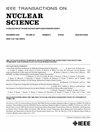Performance of F-Doped Silica Fiber Under High Ionizing Radiation Exposure
IF 1.9
3区 工程技术
Q3 ENGINEERING, ELECTRICAL & ELECTRONIC
引用次数: 0
Abstract
This work investigates the radiation-induced attenuation (RIA) performance of F-doped silica core single-mode fibers (Si-SMFs) under high ionizing radiation exposure. The Si-SMFs were fabricated using plasma chemical vapor deposition (PCVD) with a triple-cladding design to minimize internal stress. Throughout two distinct types of radiation exposure experiments, the spatial distribution and temporal evolution of RIA at telecommunication wavelengths of 1310 and 1550 nm were monitored in real-time using an optical time-domain reflectometer (OTDR). Upon completion of the initial irradiation cycle, characterized by a dose rate of 1.25 Gy(SiO2)/s and a total dose of 1 MGy(SiO2) at room temperature (RT), the RIA values for the sample fibers reached approximately 14.43 dB/km at 1310 nm and 22.81 dB/km at 1550 nm. Notably, the F-doped fibers exhibited superior RIA performance at the shorter wavelength (1310 nm) when the accumulated dose exceeded 40.5 kGy(SiO2) (高电离辐射下掺f硅光纤的性能研究
本文研究了高电离辐射下掺f硅芯单模光纤(Si-SMFs)的辐射诱导衰减(RIA)性能。Si-SMFs采用等离子体化学气相沉积(PCVD)技术制备,采用三层包层设计,以减小内应力。通过两种不同类型的辐射暴露实验,利用光学时域反射计(OTDR)实时监测了1310和1550 nm电信波长处RIA的空间分布和时间演变。在初始辐照周期结束后,样品纤维在1310 nm处的RIA值达到14.43 dB/km,在1550 nm处的RIA值达到22.81 dB/km,辐照速率为1.25 Gy(SiO2)/s,总剂量为1 MGy(SiO2)。值得注意的是,当累积剂量超过40.5 kGy(SiO2) ($\gamma $ -射线,RT)时,掺f光纤在较短波长(1310 nm)表现出优越的RIA性能。经过第二次辐照后,辐射强度在1310 nm处降至7.27 dB/km左右,在1550 nm处降至14.38 dB/km左右。本研究揭示了高电离辐射下掺f二氧化硅光纤的衰减特性及其随辐射剂量的变化规律,为光纤在辐射环境中的应用提供了有价值的见解。
本文章由计算机程序翻译,如有差异,请以英文原文为准。
求助全文
约1分钟内获得全文
求助全文
来源期刊

IEEE Transactions on Nuclear Science
工程技术-工程:电子与电气
CiteScore
3.70
自引率
27.80%
发文量
314
审稿时长
6.2 months
期刊介绍:
The IEEE Transactions on Nuclear Science is a publication of the IEEE Nuclear and Plasma Sciences Society. It is viewed as the primary source of technical information in many of the areas it covers. As judged by JCR impact factor, TNS consistently ranks in the top five journals in the category of Nuclear Science & Technology. It has one of the higher immediacy indices, indicating that the information it publishes is viewed as timely, and has a relatively long citation half-life, indicating that the published information also is viewed as valuable for a number of years.
The IEEE Transactions on Nuclear Science is published bimonthly. Its scope includes all aspects of the theory and application of nuclear science and engineering. It focuses on instrumentation for the detection and measurement of ionizing radiation; particle accelerators and their controls; nuclear medicine and its application; effects of radiation on materials, components, and systems; reactor instrumentation and controls; and measurement of radiation in space.
 求助内容:
求助内容: 应助结果提醒方式:
应助结果提醒方式:


